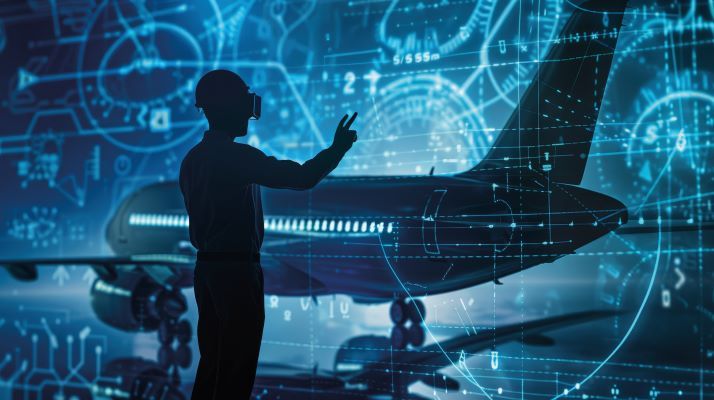In the rapidly evolving world of aviation, obsolescence management in avionics plays a pivotal role in maintaining the safety, reliability, and efficiency of aircraft systems. As technology advances, older components become outdated, posing challenges for manufacturers, operators, and maintenance teams. This article delves into the intricacies of managing obsolescence in avionics, providing insights and strategies to ensure future readiness.

Understanding Obsolescence in Avionics
Obsolescence in avionics refers to the phase when certain components, systems, or technologies become outdated and are no longer supported by the original manufacturer. This can happen due to technological advancements, changes in regulations, or a shift in market demand. The primary goal of obsolescence management is to mitigate the risks associated with outdated components and ensure the continued operation and safety of aircraft.
The Importance of Obsolescence Management
Effective obsolescence management is crucial for several reasons. Firstly, it ensures the continued airworthiness of aircraft by replacing outdated components with newer, more reliable alternatives. Secondly, it helps avoid costly downtime and maintenance delays, which can significantly impact airline operations. Lastly, proactive obsolescence management supports compliance with regulatory requirements, ensuring that aircraft meet the latest safety standards.
Challenges in Managing Obsolescence
One of the primary challenges in obsolescence management in avionics is the rapid pace of technological change. As new technologies emerge, older systems quickly become obsolete, making it difficult for manufacturers to keep up. Additionally, the aviation industry is highly regulated, requiring strict adherence to safety and performance standards. This adds complexity to the process of replacing or upgrading outdated components.
Strategies for Effective Obsolescence Management
- Proactive Planning: Implementing a proactive obsolescence management plan involves identifying potential obsolescence risks early in the design phase and developing strategies to address them.
- Supplier Collaboration: Working closely with suppliers to monitor component lifecycles and secure long-term agreements can help mitigate the impact of obsolescence.
- Technology Roadmapping: Developing a technology roadmap allows manufacturers to anticipate future trends and plan for the integration of new technologies, reducing the risk of obsolescence.
The Role of Exporters and Importers in Obsolescence Management
Exporters and importers play a vital role in the obsolescence management process by ensuring the availability of critical components and systems. By staying informed about the latest industry trends and maintaining strong relationships with suppliers, they can help mitigate the risks associated with obsolescence and support the continued operation of aircraft.
Staying Informed and Proactive
For exporters and importers, staying informed about the latest developments in avionics technology is crucial. This involves regularly monitoring industry news, attending trade shows, and participating in industry forums. By staying ahead of the curve, they can anticipate potential obsolescence issues and take proactive measures to address them.
Collaboration with Manufacturers
Building strong relationships with manufacturers is essential for effective obsolescence management. By collaborating closely with manufacturers, exporters, and importers can gain insights into component lifecycles, technological advancements, and potential obsolescence risks. This collaboration enables them to develop strategies for sourcing alternative components and ensuring the continued availability of critical systems.
Regulatory Compliance and Obsolescence Management
Compliance with regulatory requirements is a key consideration in obsolescence management in avionics. As regulations evolve, manufacturers must ensure that their systems meet the latest safety and performance standards. This often involves upgrading or replacing outdated components, which can be a complex and costly process.
Ensuring Safety and Performance
Regulatory agencies, such as the FAA and EASA, set stringent standards for the safety and performance of aircraft systems. To comply with these standards, manufacturers must regularly assess their systems for obsolescence and take appropriate measures to address any issues. This includes conducting thorough testing and validation of new components to ensure they meet the necessary requirements.
Documentation and Reporting
Maintaining accurate documentation and reporting is essential for demonstrating compliance with regulatory requirements. This involves keeping detailed records of component lifecycles, obsolescence management strategies, and any changes made to systems. By maintaining thorough documentation, manufacturers can provide evidence of compliance during audits and inspections.
Technological Advancements and Obsolescence Management
Technological advancements play a significant role in shaping the future of obsolescence management in avionics. As new technologies are developed, manufacturers must adapt their systems to incorporate these advancements while managing the risks associated with obsolescence.
Integrating New Technologies
Integrating new technologies into existing systems can be challenging, but it is essential for maintaining competitiveness and ensuring the continued operation of aircraft. This involves carefully assessing the compatibility of new technologies with existing systems and developing strategies for their integration.
Future Trends in Avionics
As technology continues to evolve, several trends are expected to shape the future of avionics. These include the increased use of artificial intelligence and machine learning, the development of more advanced communication systems, and the integration of autonomous technologies. By staying informed about these trends, manufacturers can develop strategies for managing obsolescence and ensuring the continued operation of their systems.
Conclusion
In conclusion, obsolescence management in avionics is a critical aspect of maintaining the safety, reliability, and efficiency of aircraft systems. By implementing proactive strategies, collaborating with suppliers and manufacturers, and staying informed about the latest technological advancements, stakeholders can effectively manage obsolescence and ensure the continued operation of their systems. For more insights on avionics and aerospace technology, visit our avionics development blog.

FAQ
What is obsolescence management in avionics?
Obsolescence management in avionics involves identifying and mitigating the risks associated with outdated components and systems to ensure the continued operation and safety of aircraft.
Why is obsolescence management important in the aviation industry?
Obsolescence management is important because it helps maintain the airworthiness of aircraft, avoids costly downtime, and ensures compliance with regulatory requirements.
How can exporters and importers contribute to obsolescence management?
Exporters and importers can contribute by staying informed about industry trends, maintaining strong relationships with suppliers, and collaborating with manufacturers to source alternative components and ensure the availability of critical systems.


